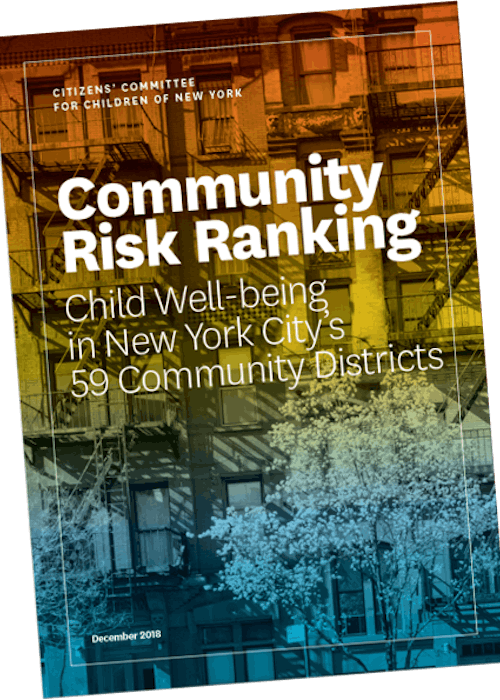

CCC’s Community Risk Ranking: Measuring Child Well-Being In New York City’s 59 Community Districts
Data Resources
December 1, 2018
CCC’s Community Risk Ranking looks at 18 different indicators across six domains of child well-being—Economic Security, Housing, Health, Education, Youth, and Family & Community—to determine where risks concentrate in New York City. Identifying where risks concentrate is important, as research tells us that the presence of multiple risk factors can have cumulative negative effects on children’s development.
In order to identify communities where families are more likely to face risks, we rank New York City’s 59 community districts from highest to lowest risk, within each domain and overall, and place community districts into one of five risk categories: highest risk, moderate-high risk, moderate risk, moderate-low risk, and lowest risk.
In this edition of the Community Risk Ranking, we report the individual indicators in each domain as well as the index scores. These data tell a detailed story of how different life can be across the city for children and their families.
Neighborhoods in New York City are continually in flux. Changes may be occurring in similar or even opposing directions from one neighborhood to the other. In each domain, we identify community districts that experienced the biggest change in their risk ranking between 2009 to 2016 and highlight their year-over-year changes for the three indicators in the domain.
Knowing where disparities are declining or increasing helps community members, policymakers, service providers, and philanthropic organizations prioritize investments and develop new programs or initiatives to achieve better outcomes for children and families in the city.
We encourage readers to visit Keeping Track Online (data.cccnewyork.org), home to our online data visualization tools, which contain data for hundreds of indicators related to child and family well-being. These tools allow users to more deeply explore the data behind the Community Risk Ranking and compare data for every indicator, across multiple years, and for all 59 community districts.
This publication serves as a starting point for further discussion and action aimed at reducing barriers to well-being for children and families, and the disparities that exist between community districts. There is also a need to delve deeper and address disparities within community districts. To that end, CCC continues to conduct community-based assessments of both assets and needs in specific neighborhoods of the city. In addition to analyzing publicly available data to highlight welcomed and worrisome trends, we speak with service providers and residents about their needs and the resources that are available to them. We engage in this work to answer some of the questions that the Community Risk Ranking raises: Why are trends in some community districts going in the opposite direction of citywide trends? What is working to ameliorate or address risks that can be replicated in other parts of the city? What barriers do residents face that prevent them from accessing needed resources or services? We hope the Community Risk Ranking inspires more community level work to identify solutions and improve outcomes in communities where risks concentrate. All children in New York City must have the opportunities they deserve to be healthy, housed, educated and safe.


